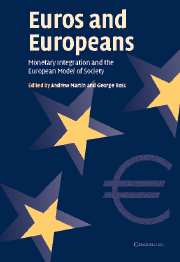Book contents
- Frontmatter
- Contents
- Preface
- List of contributors
- 1 Introduction: EMU and the European social model
- 2 The EMU macroeconomic policy regime and the European social model
- 3 Shaping a polity in an economic and monetary union: the EU in comparative perspective
- 4 Monetary integration and the French model
- 5 EMU and German welfare capitalism
- 6 Maastricht to modernization: EMU and the Italian social state
- 7 Constraint or motor? Monetary integration and the construction of a social model in Spain
- 8 The Netherlands: monetary integration and the Polder model
- 9 Belgium: monetary integration and precarious federalism
- 10 The political dynamics of external empowerment: the emergence of EMU and the challenge to the European social model
- 11 Welfare reform in the shadow of EMU
- 12 Industrial relations in EMU: are renationalization and Europeanization two sides of the same coin?
- 13 Conclusions
- References
- Index of names
- Index of subjects
1 - Introduction: EMU and the European social model
Published online by Cambridge University Press: 22 September 2009
- Frontmatter
- Contents
- Preface
- List of contributors
- 1 Introduction: EMU and the European social model
- 2 The EMU macroeconomic policy regime and the European social model
- 3 Shaping a polity in an economic and monetary union: the EU in comparative perspective
- 4 Monetary integration and the French model
- 5 EMU and German welfare capitalism
- 6 Maastricht to modernization: EMU and the Italian social state
- 7 Constraint or motor? Monetary integration and the construction of a social model in Spain
- 8 The Netherlands: monetary integration and the Polder model
- 9 Belgium: monetary integration and precarious federalism
- 10 The political dynamics of external empowerment: the emergence of EMU and the challenge to the European social model
- 11 Welfare reform in the shadow of EMU
- 12 Industrial relations in EMU: are renationalization and Europeanization two sides of the same coin?
- 13 Conclusions
- References
- Index of names
- Index of subjects
Summary
The political structure of the European economy has been fundamentally transformed by the two decades of monetary integration culminating in Economic and Monetary Union (EMU). Centuries-old national currencies were replaced by the Euro and monetary policy, a core function of the modern state, was transferred to a supranational European Central Bank (ECB). The ECB was endowed with more autonomy from EMU's member states than any other European Union (EU) institution except the European Court of Justice (ECJ) and greater independence than any other central bank in the world. The Stability and Growth Pact (SGP), also applicable to member states remaining outside EMU in addition limited member states' discretion over fiscal policy, their remaining macroeconomic policy instrument. There is no other policy domain where centralization of power in EU institutions has gone so far.
In contrast, the EU's treaty/constitution leaves authority over welfare state and employment relations institutions in member state hands. These institutions largely shape individuals' relation to the economic life of their societies throughout the life course, before, during, and after participation in the labor market. Despite important national differences, these institutions have enough in common in European countries, Britain excepted, to be understood as variants of what Europeans typically refer to as a “European social model.” This model is distinguished from the American, or Anglo-Saxon, model by its greater protection against economic insecurity, inequality, and unilateral employer power. Much domestic political conflict and partisan competition is focused on the distributive and normative issues raised by these social models.
- Type
- Chapter
- Information
- Euros and EuropeansMonetary Integration and the European Model of Society, pp. 1 - 19Publisher: Cambridge University PressPrint publication year: 2004
- 8
- Cited by



